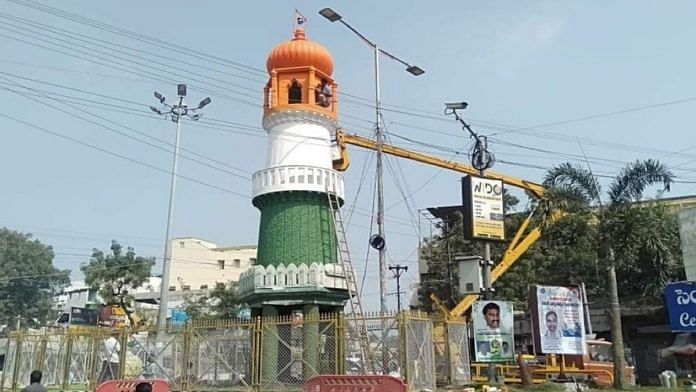Hyderabad: As the political row over the ‘Jinnah Tower’ landmark in Andhra Pradesh’s Guntur continued, the local authorities painted it in the colours of the Tricolour Tuesday, to reflect its identity as a “symbol of harmony”, the city’s municipal commissioner told ThePrint. The commissioner, Nishant Kumar, added that the national flag will be unfurled at the tower Thursday.
The moves come after members of a group called Hindu Vahini were detained last week when they tried to unfurl the national flag at the tower on Republic Day. Following that incident, the Bharatiya Janata Party (BJP) had lashed out at Chief Minister Y.S. Jagan Mohan Reddy’s government and demanded that the the landmark — named after Pakistan founder and Muslim League leader Muhammad Ali Jinnah — be renamed ‘APJ Abdul Kalam Tower’, after the late Indian president and scientist.
Even after the tower was painted in the Tricolour, the BJP maintained its demand to rename it.
“After 26th January incident & our protest, @Ysrcongress govt painted the Jinnah Tower but it looks as if they’re trying to paint their sins. Our demand is still the same – RENAME THE TOWER NAME (sic),” BJP Andhra Pradesh general secretary Vishnu Vardhan Reddy tweeted.
After 26th January incident & our protest, @Ysrcongress govt painted the Jinnah Tower but it looks as if they're trying to paint their sins.
Our demand is still same – RENAME THE TOWER NAME.@blsanthosh pic.twitter.com/LwIxHySzyD
— Vishnu Vardhan Reddy (@SVishnuReddy) February 1, 2022
Consulted ‘elders’ of all communities
The Jinnah Tower is maintained by the Guntur Municipal Corporation, and Tuesday, the local body used a crane to get the tower painted in the Tricolour.
Commissioner Nishant Kumar said the decision was taken after consulting “elders” from all communities, among others. He asserted that the tower was a symbol of harmony, but declined to comment on the “controversy”.
“We have been talking to all communities’ elders, public representatives, and officials and then we decided it must be painted in the Tricolour. We want to reflect that this tower is a symbol of harmony in Guntur and want to give out a message that India is Guntur and Guntur is India. We want to re-emphasise that Guntur is a place for people of India,” he said.
“The corporation’s responsibility is not just infrastructure maintenance but also maintaining peace and harmony in its jurisdiction,” he added.
Asked if the decision to paint the tower in the Tricolour came from the state government, Kumar declined to comment.
Also read: ‘CM Jagan wants everyone to become Christian’ — Andhra BJP bats for anti-conversion law
The controversy
The Jinnah Tower is currently at the heart of a row between the Jagan Reddy government and the BJP, following the incident with the Hindu Vahini workers.
The state police earlier told ThePrint that the group workers were detained over law and order issues as the municipal corporation had received some “messages” that the tower would be demolished if it wasn’t renamed.
“Why will the police stop someone who wants to unfurl a national flag? We had to detain them for law and order issue… The area is communally sensitive and the corporation received messages from some groups about demolishing it,” Guntur Urban SP Arif Hafeez told ThePrint earlier.
However, Hafeez said he had no idea of who exactly those groups were.
Objecting sharply to the police action, BJP national secretary and state co-in charge Sunil Deodhar said “we are not in Pakistan”.
“CM @ysjagan – mind that we are not in Pakistan. Shame on AP Govt. Which prevented Hindu Vahini activists from unfurling the National Flag on #RepublicDay, we will not leave the fight of renaming Jinnah Tower in #Guntur as Dr APJ Abdul Kalam Tower,” he tweeted last week.
CM @ysjagan mind that we are not in Pakistan.
Shame on AP Govt. Which prevented Hindu Vahini activist to unfurl National Flag on #RepublicDay, we will not leave the fight of renaming Jinnah Tower in #Guntur as Dr APJ Abdul Kalam Tower. pic.twitter.com/QCmoUvf15q
— Sunil Deodhar (@Sunil_Deodhar) January 26, 2022
He also questioned the “relevance” of the name ‘Jinnah Tower’, adding that the state BJP has been constantly demanding that it be renamed after Bharat Ratna awardee Kalam, but the CM wasn’t inclined to do so “to appease the minority community”.
According to historians, the tower was built before Partition, sometime between 1942 to 1945. It is said that Lal Jan Basha, who was a legislative member from Guntur in the erstwhile Madras Presidency, built the tower to honour Jinnah, who helped in reducing the sentence of 14 people from the Muslim community upon Basha’s request. All 14 were on death row over riots in Guntur’s Komerapudi village.
(Edited by Amit Upadhyaya)
Also read: KCR hits out at Modi govt, describes Union budget as ‘golmaal budget’






